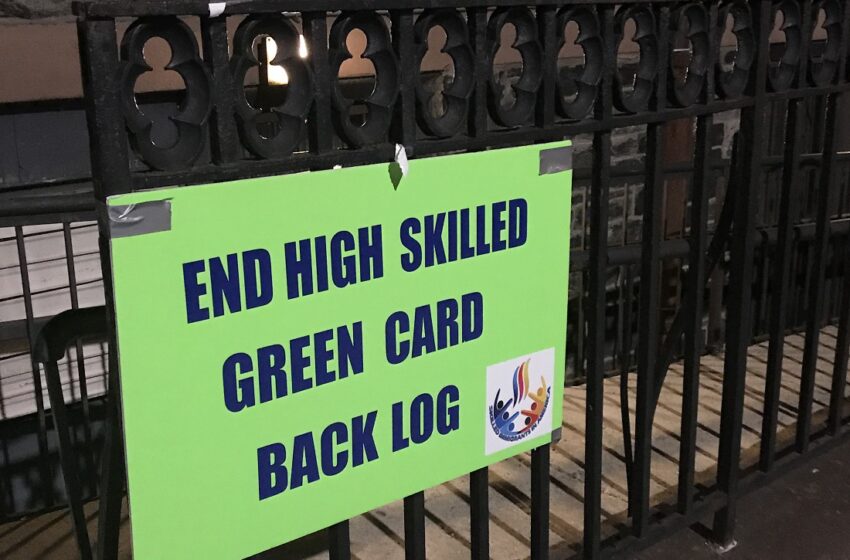Indians must wait more than a century for a green card: study

Photo credit: Natasha Israni
To address green card backlogs, Congress should start by waiving the unnecessarily onerous rules and arbitrary caps
Noting the plight of Indians, who must wait more than a century for a green card, a new study suggests that Congress should address green card backlogs by waiving the unnecessarily onerous rules and arbitrary caps.
The employment-based green card backlog has grown to 1.8 million as of March 2023 — up from about 1.2 million in 2018 when the government first provided detailed data, notes the study by Cato Institute, a Washington, DC,-based libertarian think tank.
The overall cap is set at 140,000 per year plus any unused family-sponsored green cards.
Indian American lawmakers call for immigration reform to reduce green card backlog (December 21, 2022)
In FY 2024, about 8 percent of pending employment-based applications will be approved for a green card. But most of these green cards will not go to the applicants who have waited the longest, says David J. Bier, Associate Director, Immigration Studies at the Cato Institute.
“Instead, because of the country caps, applicants who apply over the next year will pass applicants from China and India—many of whom have already waited more than a decade,” he says.
“In fact, Indians — who make up half the applicants in the employer-sponsored categories —must wait more than a century for a green card,” Bier writes in a paper reviewing the history of immigration caps and charting the development of green card backlog.
Noting that the US green card approval rate has reached record lows due to a century of dysfunctional and restrictive immigration policy, he also suggests approving 35 million pending applications to unleash the economic potential of immigrants.
“Congress should see these green card applicants as a historic opportunity to unleash the economic potential of immigrants,” says Bier pointing out that “a century of dysfunctional and restrictive immigration policy has led to an unprecedentedly high number of green card requests.”
Waiting for the Wait to End: The human face of Indian immigrants caught in the Green Card backlog (December 4, 2018)
“Only 3 percent of green card applicants waiting for approval will likely receive permanent residence in the United States in 2024,” Bier notes.
“In a world where 97 percent of applicants are turned away, the vast majority of people around the world feel that they have no way to come to the United States legally,” he says. “This accurate perception leads millions to enter illegally.”
The buildup of 35 million green card applicants may seem politically impossible to fix, but in Bier‘s view, the United States has the capacity to assimilate an even larger number.
With population and labor force growth near all-time lows, Congress should seize the chance to improve the country’s long-term demographic outlook, he says.
“There is no reason to turn away people who will contribute significantly to America’s economy and society,” adds Bier.
H-4 and H-1: Time for Indian immigrants to speak up on immigration policy, says author Amy Bhatt (January 5, 2019)
Noting that since the 1920s, the United States has tightly restricted legal immigration, Bier says, “This century of low legal limits has produced high levels of illegal immigration and a historic level of requests for green cards.”
Currently, about 34.7 million applications are pending—up from about 10 million in 1996. As legal immigration caps plus uncapped categories permit only about 1.1 million green cards for FY 2024, 97 percent of green card applicants will not receive one this year.
Approving all existing applicants and increasing legal immigration nearly fivefold would shield the United States from many adverse consequences of demographic decline and reduce illegal immigration, Bier suggests.
“Even with this seemingly massive increase in admissions, America’s immigrant population share would remain below the share in Canada, and US population and labor force growth would stay under their levels of the 1980s,” he says.
Congress should see the massive demand for green cards as a historic opportunity—an untapped, underutilized resource that can aid the country, writes Bier.
The unstable life of Indians on H-1B visa in the US due to visa renewal policy (October 28, 2016)
Backlogged immigrants are likely to enter the United States and start working at higher rates than the general population, and they also appear to be more educated on average.
The United States is facing both short‐ and long-term demographic and economic challenges that these aspiring Americans can help address.
The US population in the 2020s is growing at the slowest rate in history, and almost all the growth in the past year came from immigration, he says. “The slowdown and eventual decline of the US population will have massively negative consequences for US economic growth in the 21st century.”
The slowdown in population growth is so great that even 35 million new immigrant workers would be insufficient to meet the labor needs of the United States over the next decade, Bier says.
To fund Social Security at a sufficient level to cover expenses, the United States will need 38 million more workers than the government expects will be in the country by 2035, he says.
To get the labor force growth rate merely back to the same rate as the 1980s will take 49 million more workers, yet the 2010s saw an increase of fewer than 7 million workers.
Reverse brain drain – the experience of three couples who moved back to India from the US (January 20, 2014)
“To address green card backlogs, Congress should start by waiving the unnecessarily onerous rules and arbitrary caps to approve current green card applicants,” Bier says. “Because the current backlog reflects years of unaddressed requests, annual legal immigration would only need to increase more gradually to meet future demand.”
For instance, the portion of the family-sponsored backlog caused by caps that were set in 1990 is about seven million. If those caps had simply increased proportionally to increases in green cards for the uncapped immediate relative categories—an average of just 200,000 per year—six million additional green cards would have been issued in those categories, approving about 85 percent of this backlog.
Overall, since 1990, pending green card requests for family, employment, asylum, lottery, and all other categories have increased at an annual rate of about 800,000 faster than the number of approvals, he says. Congress would need to add at least this amount to the green card caps to prevent green card backlogs from escalating again. But more will likely be needed.
The paper estimates that granting green cards to the 35 million applicants in 2024 and then permanently increasing legal immigration to 5 million annually would likely increase the US immigrant population by only about 40 million by 2033, leading to an immigrant share of 22 percent.
“Such a substantial reform would erase the buildup of green card applications and put America back on a fiscally and economically sustainable demographic path. It would also greatly reduce illegal immigration,” he says.
“Yet every day that passes without reform only makes finding a sensible solution to immigration more difficult. Congress should act now,” Bier says.
ALSO READ:
The newly passed H.R.1044 raises caps for family-based green cards (July 11, 2019)
Waiting for the Wait to End: The human face of Indian immigrants caught in the Green Card backlog (December 4, 2018)
Will Trump’s proposed immigration reform benefit Indians? What will be its impact on Green Card backlog? (May 20, 2019)
RHC’s H-1B rally demands elimination of Green Card backlog, protection for ‘DALCA’ children (February 10, 2019)
Trump talks about changes in H-1B Visa, including a possible citizenship (January 11, 2019)
Trump’s tweet on H-1B and path to citizenship evokes lukewarm response (January 12, 2019)
High-skilled Indian workers, DALCA kids, rally on Capitol Hill to clear green card backlog (June 15, 2018)

